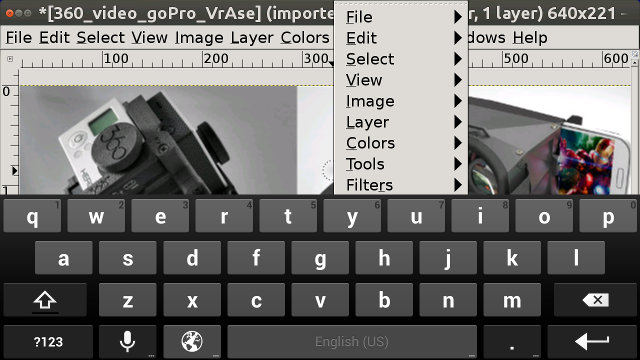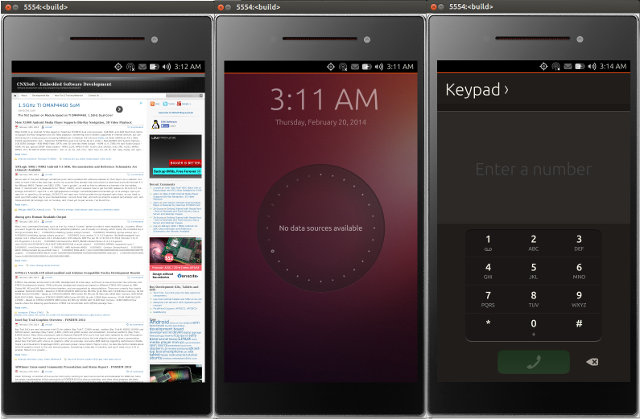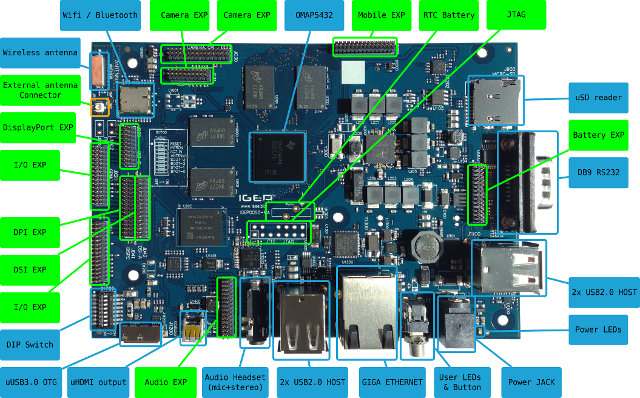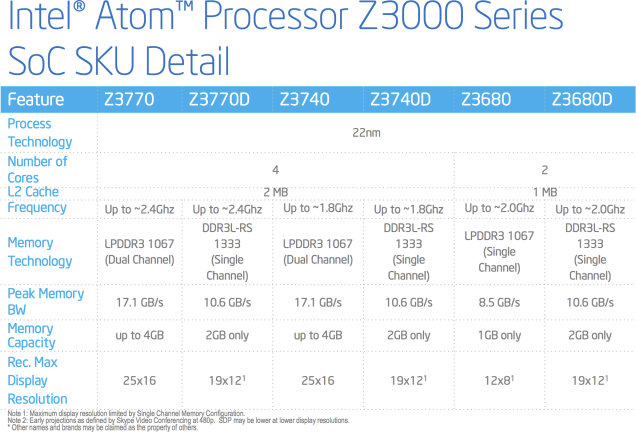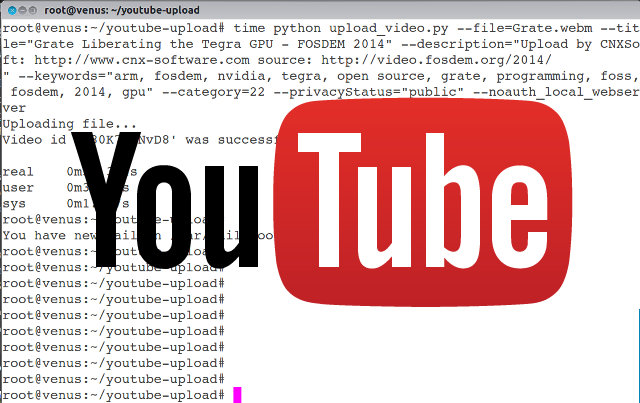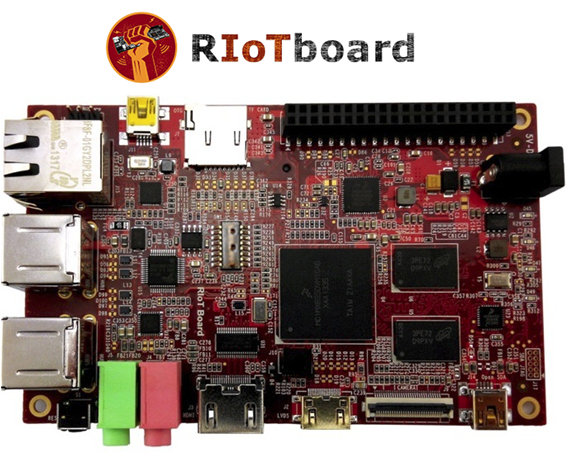It has been feasible to run Linux apps in Android by installing a Linux distribution in a chroot using some app such as Complete Linux Installer, and accessing the graphical application via VNC. I tested this solution with Ubuntu in Android using ODROID-X development board, and it worked fine, except the performance was rather poor. There’s now another solution with XServer XSDL app, X Window System server for Android, that can be used to stream application from a Linux PC or to launch app from a Linux distribution installed in your Android device. I’ve given a quick try in my Android phone, and after installing and running the app, it will give instructions to launch gimp in your Linux PC to use it in the phone: Launch these commands on your Linux PC env DISPLAY=192.168.0.100:0 metacity & env DISPLAY=192.168.0.100:0 gimp Just type this command line into a terminal, and gimp […]
Linaro 14.02 Release with Linux Kernel 3.14 and Android 4.4.2
Linaro 14.02 has just been released with Linux Kernel 3.14-rc3 (baseline), Linux Kernel 3.10.30 (LSK), and Android 4.4.2 r2. There are been a lot of patches for Linaro members boards, and including the latest GTS big.LITTLE processing patch, as well as speeds up to Android 4.4 performance. There’s also a Linux image (password protected) for Huawei D01 board with a 16-core ARM Cortex A15 @ 1.5 GHz SoC with up to 64 GB memory, that must be an unannounced SoC for base stations or other network equipment. This month Linaro also made two important announcements: Qualcomm is now a Linaro member, and the Linaro Security Working Group (SWG) has been setup to develop open source secure software for the ARM architecture. The first projects will be reference implementations of the W3C Embedded Media Extension (EME), and secure boot for the 64-bit ARM Cortex-A series processors. They’ll also work on security […]
Flappy Bird Sucks, Let’s Play Flappy Tux Instead! Or How to Modify APK Files
Flappy Bird is a ridiculous fad, and I promised myself not to write about this silly game. I managed to resist when somebody showed off their Arduino powered real-life Flappy Bird, but then XDA developers mentioned one of their member posted instructions to customize Flappy Bird game. I thought it might be fun to personalize the game with pictures of friends or family members, and at the same time, learn how to hack apk files. Instead of real persons, I’ve replaced the original bird, by Tux, the official Linux mascot, flapping wings not included. The instructions in XDA dev forums are mainly for Windows, but I’ve adapted them to Linux, and “created” “Flappy Tux” from Ubuntu 13.10. I’ll assume you’ve already installed OpenJDK and the Android SDK and have a working Android app development environment. I think we just need adb and aapt from android-sdk-linux/platform-tools/bin to be in the path. […]
Try Ubuntu Touch on Your Computer with Ubuntu Touch Emulator
Canonical has just announced Meizu (China) and Bq (Europe) will be the first manufacturers to launch Ubuntu Touch phones at the end of 2014. But if you want to try Ubuntu Touch, and don’t own a Google Nexus 4 or 7, or simply don’t want to flash Ubuntu Touch to your devices, you can do so using Ubuntu Touch x86 Emulator in your computer running Ubuntu , or in an Ubuntu Virtual machine in Virtualbox or VMWare. The emulator has been available since last November, but Ricardo Salveti announced an updated version, the first public preview, with the following changes: Better TLS handling (not using the Android slots, but using pthread_set/getspecifics instead) Qt packages compatible with OpenGL ES 2.0 available at https://launchpad.net/~rsalveti/+archive/qt-gles-test It has been tried on Ubuntu Trusty (14.04), but I could run it just fine on Ubuntu Saucy (13.10), by following the instructions below in a terminal: Download […]
IGEPv5 OMAP5432 Development Board is Now Available for 149 Euros
ISEE IGEPv5 development board announced in October 2013, and powered by Texas Instrument OMAP5432 dual core Cortex A15 + dual core Cortex M4 SoC, POWERVR SGX544MP2 and Vivante GC320 GPUs is now available for as low as 149 Euros. There are two versions: “IGEPv5 OMAP5432 Communication Edition” for hobbyists with limited support, and “IGEPv5 OMAP5432” directly supported by ISEE. There’s also “IGEPv5 Custom Design” if you have specific requirements for your product. Hardware specifications are shared by both versions but with significant differences (CE = IGEPv5 OMAP5432 Community Edition, ISEE = IGEPv5 OMAP5432): SoC – Texas Instruments OMAP5432 dual core Cortex A15 up to 1.5 GHz (CE) or 2 GHz (ISEE), dual core Cortex M4, with POWERVR SGX544 dual-core GPU, Vivante GC320 GPU, and TMS320DMC64x DSP System Memory CE – 1GB DDR3 @ 1066 MHz ISEE – Up to 4 GB DDR3 RAM expandable to 4GB Storage CE – No eMMC, […]
Intel Bay Trail Z3700 Series Overview, Benchmarks, Hardware, Documentation and Linux Support
After seeing the discussion about ARM vs x86 (Bay trail) for the future Dragon Pyra open source game console, I’ve realized many people, including myself, do not know about the different resources available to develop hardware and software for Intel Bay Trail SoCs for tablets such as Atom Z3740 and Z3770, so I decided to have a look. Intel Atom Bay Trail Z3700 Series Overview Intel Z3600 series and Z3700 series are respectively dual core and quad core Bay Trail-T SoCs for Android and Windows 8 tablets. There are 4 quad core models: Z3740, Z3740D, Z3770, and Z3770D, and 2 dual core processors: Z3680 and Z3680D. The dual core versions are reserved for Android only, and there’s no product page on Intel for now, so I’ll focus this post on Z3700 series only. I have no idea what the “D” in Z3740D is for, except it;’s not related to Desktop, […]
How to Upload YouTube Videos with the Command Line in Linux
Like many people, I access Internet via an ADSL connection at home. ADSL stands for “Asymmetric Digital Subscriber Line”, with Asymmetric being the key word here, as it just mean your download speed will be (much) higher than your upload speed. My ISP promises a theoretical 10 Mbps download speed, and 512 Kbps upload speed, and this is pretty close in reality: Data Rate: 10240 (downstream), 509 (upstream) kbps. Assuming a 265MB video, in the very best case (63 KB/s), it would take 1 hour and 12 minutes to upload a video to YouTube, but in practice it’s often closer to 2 or 3 hours. If it’s a video you’ve shot yourself, and copied inside your computer, there’s very little you can do, except processing the video with tools such as HandBrake to make it smaller before upload. But if the video files are located somewhere in the Internet, and […]
$74 RIoTBoard Development Board Features Freescale i.MX 6Solo
RIoTBoard, which stands for “Revolutionizing the Internet of Things Board”, is a new Android & GNU/Linux development board sold by Element14 /Newark powered by Freescale i.MX6Solo Cortex A9 processor. The board also features 1GB DDR3 RAM, 4GB eMMC and plenty of ports including Gb Ethernet, HDMI, and more. The board can be used to design netbooks , nettops, mobile internet devices (MIDs), PDAs, portable media players (PMP) with HD video capability, portable navigation devices (PNDs), industrial control and test and measurement (T&M), and single board computers (SBCs). RIoTBoard specifications: SoC – Freescale i.MX 6Solo ARM Cortex A9 MPCore Processor @ 1 GHz with Vivante GC880 and GC320 GPUs for 3D & 2D graphics, and HD video processing unit. System Memory – 1GB DDR3 RAM Storage – 4GB eMMC, microSD and SD card slots Video Output – HDMI, LVDS, and parallel RGB interfaces Audio I/O – Analog headphone/microphone, 3.5mm audio jack […]


